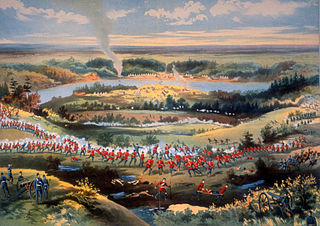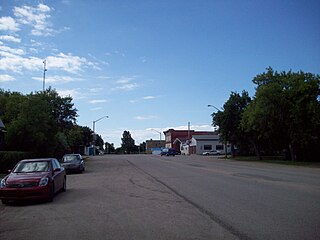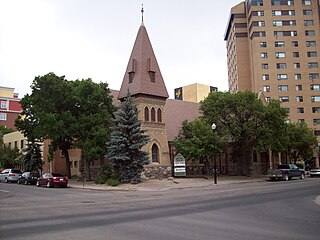This article needs additional citations for verification .(July 2010) |
The timeline of Regina history shows the significant events in the history of Regina, Saskatchewan, Canada.
This article needs additional citations for verification .(July 2010) |
The timeline of Regina history shows the significant events in the history of Regina, Saskatchewan, Canada.




Saskatchewan is a province in Western Canada, bordered on the west by Alberta, on the north by the Northwest Territories, on the east by Manitoba, to the northeast by Nunavut, and to the south by the United States. Saskatchewan and Alberta are the only landlocked provinces of Canada. In 2023, Saskatchewan's population was estimated at 1,225,493. Nearly 10% of Saskatchewan's total area of 651,900 km2 (251,700 sq mi) is fresh water, mostly rivers, reservoirs, and lakes.

The North-West Rebellion, also known as the North-West Resistance, was an armed resistance movement by the Métis under Louis Riel and an associated uprising by Cree and Assiniboine of the District of Saskatchewan, North-West Territories, against the Canadian government. Many Métis felt that Canada was not protecting their rights, their land, and their survival as a distinct people. Fighting broke out in late March, and the conflict ended in June. About 91 people were killed in the fighting that occurred that spring before the conflict ended with the capture of Batoche in May 1885.

Regina is the capital city of the Canadian province of Saskatchewan. The city is the second-largest in the province, after Saskatoon, and is a commercial centre for southern Saskatchewan. As of the 2021 census, Regina had a city population of 226,404, and a Metropolitan Area population of 249,217. It is governed by Regina City Council. The city is surrounded by the Rural Municipality of Sherwood No. 159.

William Henry Jackson, also known as Honoré Jackson or Jaxon, was secretary to Louis Riel during the North-West Rebellion in Canada in 1885. He was married to Aimée, a former teacher in Chicago.

Events from the year 1885 in Canada.
The Saskatchewan New Democratic Party (NDP) is a social-democratic political party in the Canadian province of Saskatchewan. The party was founded in 1932 as the Farmer-Labour Group and was known as the Saskatchewan section of the Co-operative Commonwealth Federation (CCF) from 1935 until 1967. The NDP currently forms the Official Opposition and is led by Carla Beck.

Allan Emrys Blakeney was a Canadian politician who served as the tenth premier of Saskatchewan from 1971 to 1982. Originally from Bridgewater, Nova Scotia, Blakeney moved to Regina, Saskatchewan, and worked in the province's civil service before running for office with the Co-operative Commonwealth Federation (CCF) under Tommy Douglas. Blakeney became leader of the Saskatchewan New Democratic Party (NDP) in 1970. Altogether, he was a member of the Legislative Assembly of Saskatchewan from 1960 to 1988.

Batoche, Saskatchewan, which lies between Prince Albert and Saskatoon, was the site of the historic Battle of Batoche during the North-West Rebellion of 1885. The battle resulted in the defeat of Louis Riel and his Métis forces by Major General Frederick Middleton and his Northwest Field Force. Batoche was then a small village of some 500 residents. The site has since become depopulated and now has few residents. The 1885 church building and a few other historic buildings have been preserved, and the site is a National Historic Site.

The trial of Louis Riel took place in Regina, Canada, in 1885. Louis Riel had been a leader of a resistance movement by the Métis and First Nations people of western Canada against the Government of Canada in what is now the province of Saskatchewan. Known as the North-West Rebellion, this resistance was suppressed by the Canadian military, which led to Riel's surrender and trial for treason. The trial, which took place in July 1885 and lasted five days, resulted in a guilty verdict. He was also given a choice to plead guilty or insanity. Riel was subsequently executed by hanging, an outcome which has had a lasting negative impact on relations between Anglophone Canadians and the Riel supporters among French Canadians.

Qu'Appelle is a town in Saskatchewan, located on Highway 35 approximately 50 kilometres (31 mi) east of the provincial capital of Regina.
Romanian Canadians are Canadian citizens of Romanian descent or Romania-born people who reside in Canada.

St Paul's Anglican Cathedral is an historic church building located on the outskirts of Regina's central business district. Built as a parish church in 1894–1895, it became the pro-cathedral of the Anglican Diocese of Qu'Appelle in southern Saskatchewan, Canada, in 1944 when pro-cathedral status was removed from St Peter's, Qu'Appelle, in the eponymous former see city which had become moribund. In 1973, when it had become clear that the once-planned grand cathedral for Regina — at the corner of Broad Street and College Avenue — was no longer a feasible project, its status was raised to that of cathedral.

The history of Regina, Saskatchewan, the capital of the Canadian province of Saskatchewan. Prior to the province's establishment, Regina served as the territorial headquarters of the then-North-West Territories and district headquarters of the territorial district of Assiniboia.

Government House in Regina, Saskatchewan, Canada, is the official office of the lieutenant governor of Saskatchewan. It was first constructed as a residence for the lieutenant governor of the North-West Territories, whose territorial headquarters were in Regina. When the provinces of Saskatchewan and Alberta were created out of the Territories in 1905, Regina became the capital of Saskatchewan and Government House became the official residence of the lieutenant governor of Saskatchewan. It was vacated in 1944 and then returned to official ceremonial use in 1984.

Many historically significant buildings in Regina, Saskatchewan were lost during the period 1945 through approximately 1970 when the urge to "modernize" overtook developers' and city planners' sense of history and heritage. The old warehouse district to the north of the old CPR tracks was Regina's original commercial raison d'être once Lieutenant-Governor Edgar Dewdney had established the site of his considerable landholdings as the Territorial Capital. 1899 to 1919 Washington Park and 3431 Dewdney Ave building as CPR commercial logistics building, expanded connected with significant conversion of shipping of commercial goods from train to truck and cancellation of passenger service on the railway, the Warehouse District immediately adjacent to the train line has ceased to be exclusively industrial in character. Some areas of the Warehouse District have been transformed into a shopping, entertainment and residential precinct.

Highway 11 is a major north-south highway in Saskatchewan, Canada that connects the province's three largest cities: Regina, Saskatoon and Prince Albert. It is a structural pavement major arterial highway which is approximately 391 kilometres (243 mi) long. It is also known as the Louis Riel Trail (LRT) after the 19th century Métis leader. It runs from Highway 1 in Regina until Highway 2 south of Prince Albert. Historically the southern portion between Regina and Saskatoon was Provincial Highway 11, and followed the Dominion Survey lines on the square, and the northern portion between Saskatoon and Prince Albert was Provincial Highway 12.

History of Saskatchewan encompasses the study of past human events and activities of the Canadian province of Saskatchewan, the middle of Canada's three prairie provinces. Archaeological studies give some clues as to the history and lifestyles of the Palaeo-Indian, Taltheilei, and Shield Archaic traditions who were the first occupants of the prehistoric era of this geographical area. They evolved into the history of the First Nations people who kept their history alive in oral tradition. The First Nation bands that were a part of this area were the Chipewyan, Cree, Saulteaux, Assiniboine, Atsina, and Sioux.
The Politics of Saskatchewan relate to the Canadian federal political system, along with the other Canadian provinces. Saskatchewan has a lieutenant-governor, who is the representative of the Crown in right of Saskatchewan; a premier—currently Scott Moe—leading the cabinet; and a legislative assembly. As of the most recent provincial election in 2020, the province is divided into 61 electoral districts, each of which elects a representative to the Legislature, who becomes their member, or MLA. In 2020, Moe's Saskatchewan Party was elected to a majority government. Regina is the provincial capital.

Seven neighbourhoods are of considerable note:
The Saskatchewan doctors' strike was a 23-day labour action exercised by medical doctors in 1962 in the Canadian province of Saskatchewan in an attempt to force the Co-operative Commonwealth Federation government of Saskatchewan to drop its program of universal medical insurance. The strike was from July 1, the day the Saskatchewan Medical Care Insurance Act took force, to July 23.